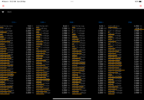What SOC had it mostly been at ?
What kind of climate? Parked outside or garage?
In average temperatures we would expect around 10% (10-11%) calendar aging if the SOC was mostly 70-90%.
I usually charge it to 90%, and it stays between 40% and 90% most of the time. There was one time where it dropped to 1%. Charged a few times a year to 90% at supercharger.
Average temperature, parked inside garage always




